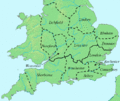Coenwulf of Mercia facts for kids
Quick facts for kids Coenwulf |
|
|---|---|

Coenwulf's portrait from the "Coenwulf mancus", a gold coin discovered in Bedfordshire in 2001.
|
|
| King of Mercia | |
| Reign | 796–821 |
| Predecessor | Ecgfrith |
| Successor | Ceolwulf I |
| Died | 821 Basingwerk, Flintshire |
| Spouse | Cynegyth (possibly) Ælfthryth |
| Issue | Cynehelm Cwoenthryth |
| House | C-dynasty |
| Father | Cuthberht |
Coenwulf (who also went by Cenwulf or Kenulf) was a powerful noble from Mercia. He became the King of Mercia in December 796 and ruled until his death in 821. He said he was related to Cenwalh, who was the brother of famous kings Penda and Eowa. King Ecgfrith of Mercia died very suddenly. This helped Coenwulf become king, but no one ever officially blamed him for Ecgfrith's death. Coenwulf quickly showed he was a strong leader. He brought back Mercia's power in southern England. He was the last Mercian king to have so much control over other kingdoms.
Contents
Mercia's Power Before Coenwulf
For most of the 700s, Mercia was the strongest kingdom among the Anglo-Saxon lands south of the Humber River. King Æthelbald, who started ruling in 716, became the main ruler of the southern Anglo-Saxons by 731. He was killed in 757. After him, Beornred ruled briefly. But within a year, Offa took the throne.
Offa was a very powerful king. His daughter Eadburh married Beorhtric of Wessex in 789, making Wessex an ally. Offa also took strong control of Kent in the 780s. He also became the main ruler of East Anglia. He even ordered the execution of East Anglia's king, Æthelred, in 794.
Offa seemed to want his son, Ecgfrith, to be the only choice for king. Ecgfrith did become king after Offa. However, he ruled for less than five months before Coenwulf became king.
Coenwulf Becomes King
The Anglo-Saxon Chronicle says that Ecgfrith ruled for only 141 days. We know Offa died in 796, either on July 26 or July 29. This means Ecgfrith died around December 14 or December 17 of the same year. Coenwulf then took over as king.
Coenwulf's family might have been linked to the royal family of the Hwicce. This was a smaller kingdom within Mercia, located near the lower river Severn. It seems Coenwulf's family was powerful, but they were not directly from the recent Mercian royal line.
Coenwulf's Rule and Challenges
In his early years as king, Coenwulf faced a rebellion in Kent. Kent had been under Offa's control. Eadberht Præn came back from exile in Francia (modern-day France) to claim the Kentish throne.
Dealing with Kent
Coenwulf did not want to attack Kent without the approval of Pope Leo III. He wanted the Pope to agree that Eadberht was not fit to be king. This was because Eadberht had reportedly been a priest. As a priest, he would have given up his right to rule. Coenwulf wrote to the Pope. He also asked Leo to move the main church office for southern England to London, away from Canterbury.
Pope Leo refused to move the church office to London. However, in the same letter, he agreed that Eadberht's past as a priest made him unable to be king. With the Pope's support, Coenwulf invaded Kent. He took back control of the kingdom. Eadberht was captured and blinded.
Control Over East Anglia and Wales
Coenwulf also seemed to lose control of East Anglia early in his reign. King Eadwald started minting his own coins, which showed he was independent. Coenwulf's coins appeared again in East Anglia in 805. This means Mercia had regained control of the kingdom.
Coenwulf led several military campaigns against the Welsh. Records show only one conflict with Northumbria in 801. However, it is likely that Coenwulf continued to support those who opposed the Northumbrian king Eardwulf.
Conflict with the Church
Coenwulf had a disagreement with Archbishop Wulfred of Canterbury. Their conflict was about whether ordinary people (not priests) could control religious places like monasteries. Their relationship became so bad that the archbishop could not do his job for at least four years.
Some progress was made in 822 with Coenwulf's brother and successor, King Ceolwulf. But a final agreement was not reached until about 826. This agreement was between Wulfred and Coenwulf's daughter, Cwoenthryth. She had gained a lot of religious property from her father.
Coenwulf's Death and Legacy
Coenwulf died in 821 at Basingwerk. This place is near Holywell, Flintshire. He was probably getting ready for a military campaign against the Welsh. His brother and successor, Ceolwulf, led this campaign the next year. Coenwulf's body was moved to Winchcombe. He was buried in St Mary's Abbey, which is now known as Winchcombe Abbey.
Coenwulf was followed by his brother, Ceolwulf. A story from after the Norman Conquest says that Coenwulf's son Cynehelm was killed so that Ceolwulf could become king. However, within two years, Ceolwulf was removed from power. The kingship then passed out of Coenwulf's family forever.
Coenwulf was the last king of Mercia to have a lot of power over other Anglo-Saxon kingdoms. Within ten years of his death, the kingdom of Wessex began to rise under King Egbert. Mercia never got back its former strong position.
A lead seal that belonged to King Coenwulf was found in Italy in the 1800s. It is now kept in the British Museum.
Family Life
Coenwulf had two children that we know about:
- Cynehelm (died 812): He was supposed to be the next king but passed away before his father.
- Cwoenthryth: She was an abbess (head of a monastery for women) in Winchcombe, Gloucestershire. Some stories suggest she was involved in her brother Cynehelm's death.
Images for kids
See also
 In Spanish: Coenwulf de Mercia para niños
In Spanish: Coenwulf de Mercia para niños




